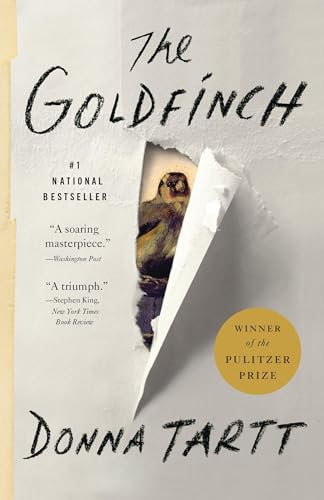You ever picked up a book thinking it would be a quiet afternoon read, only to find yourself lost in an unexpected, emotional rollercoaster? That’s exactly what happened when I picked up The Goldfinch by Donna Tartt. In this review, I’ll share my thoughts on the thrilling plot twists, rich character development, intricate writing style, and deep themes that make this book a mesmerizing read. But I’ll also be honest about the places where things got a bit tangled and overwhelming. Grab your cup of tea, sit back, and let me guide you through this captivating journey!
In a nutshell
“The Goldfinch” by Donna Tartt is a gripping novel that blends elements of literary fiction, mystery, and drama. It’s a hefty tome, both in size and emotional weight! The story follows young Theo Decker, who survives a tragic accident, leading him on a life-altering journey. He becomes entwined with a centuries-old painting called “The Goldfinch,” and trust me, this little canvas packs a punch!
The book dives deep into themes of loss, identity, and the everlasting power of art. We see Theo grapple with the chaos of life and those pesky twists of fate. Can he find hope amidst the rubble? That’s the million-dollar question!
Tartt’s writing is like a rich tapestry, weaving colorful characters and intricate settings. Sometimes though, it feels like she used a bit too much thread, and it gets tangled up! Despite this, the detailed world she creates draws you in, making “The Goldfinch” a compelling and thought-provoking read. So, grab a comfy chair, a cup of tea, and prepare for a rollercoaster of emotions.
Plot Twists and Turns: A Wild Ride in the Literary World
When it comes to plot twists and turns, some books leave you feeling like you’re on a rollercoaster—and not always the fun kind. Luckily, The Goldfinch by Donna Tartt offers the best kind of ride. I remember reading it and feeling like a detective trying to piece together the puzzle while losing my mind in the process. I mean, my brain felt like it was jogging on a treadmill while my heart was doing the Macarena! It was wild.
The book plays with your expectations, keeping you on your toes. One moment, you’re deep into the art world, and the next, you’re tangled up in a world of crime and shady dealings. Talk about a dramatic tonal shift! It’s like going from eating a gourmet dessert to gobbling up fast food. Yet, somehow, Tartt makes it work.
But let’s be honest, not all plot twists are created equal. There are moments in The Goldfinch where I felt like Tartt threw in surprises just for the shock value. It’s like she channeled her inner magician and went, “Tada! Magic plot bunny out of my hat!” While it mostly worked, a few twists felt a bit forced, leaving me scratching my head.
Still, the surprises kept me engaged, and I found myself eagerly flipping pages while my cat judged me for ignoring him. If you want a book that juggles suspense, drama, and art theft with the poise of a circus performer, well, you’ve found your gem.
As I finish discussing the wild plot ride, let’s strap in again and explore the fascinating terrain of character development and depth in the next section!
Exploring Character Development in ‘The Goldfinch’
Character development in ‘The Goldfinch’ reminds me of the time I cared for a ficus plant—patience, nurturing, and sometimes unclear results. Theo Decker, the protagonist, is like that ficus you hope will flourish. Having survived a traumatic event, Theo’s journey is a rollercoaster. His complexity feels like trying to solve a Sudoku puzzle with a few missing numbers. You get the picture!
Donna Tartt unravels Theo’s life in surprising ways, sometimes leaving you bewildered. Imagine my surprise when my buddy claimed he’d teach me painting—without any brushes! That’s how intriguing yet confusing Theo’s bonds with characters like Boris and Pippa feel. The relationships are twisty, layered, and define Theo’s choices throughout.
Even Mrs. Barbour is a character who intrigued me, reminding me of my old school principal—firm yet somehow charming. Tartt crafts these characters in such a way that they echo familiar, real-life people, inviting readers to reflect on their own relationships. I found Theo’s growth relatable, like trying to grow as a cook only to burn toaster waffles. It’s a blend of humorous missteps and heartfelt growth.
The level of detail in Theo’s internal struggles and interactions with others is both a pro and a con. While it’s enriching, at times, it can feel like wading through endless descriptions. This may test your patience, like waiting for my aunt to finish explaining her cat’s dietary preferences. But it keeps you hooked, invested in discovering who Theo ultimately becomes. So, hang in there! It’s worth the ride.
In our next exciting chapter, we’ll navigate through Tartt’s writing style and language—like a wordsmith’s treasure hunt! Stay tuned!
Exploring the Writing Style and Language in The Goldfinch
The writing style in The Goldfinch will either dazzle you or make your eyebrows raise like a surprised emoji. Donna Tartt employs a stunningly detailed and picturesque language that makes even my morning coffee look dull. Her prose paints vivid scenes that seep into the pages like coffee on a white shirt. And trust me, I know a thing or two about that!
With her knack for language, Tartt takes readers on a journey that’s more colorful than a box of crayons. You find yourself slogging through lengthy descriptions, yet secretly loving it as if it was a guilty pleasure like eating ice cream for breakfast. I remember reading a passage about a teacup and suddenly feeling an existential crisis. How does she manage to do that?
Though sometimes, the prose might feel like it’s trying too hard to impress, like wearing a tuxedo to a backyard barbecue. I spotted a few instances where the dialogue seemed more like a monologue, making me wonder if I’d accidentally picked up a soliloquy anthology. But hey, nobody’s perfect, right? Despite these slight quirks, Tartt’s rich narrative makes The Goldfinch an undeniable page-turner.
Overall, the language and writing style in The Goldfinch left me feeling like I had taken a literary rollercoaster ride. Perhaps a bit dizzy, but definitely exhilarated. Prepare yourself for the next section, where we’ll unravel more mysteries as we delve into the themes and symbolism. Spoiler alert: It’s going to be as deep as a philosopher at a coffee shop!
Themes and Symbolism in The Goldfinch
“The Goldfinch” is packed with themes and symbolism that’ll keep you thinking long after you close the book. The titular goldfinch painting is at the heart of it all. It symbolizes beauty, art’s timeless nature, and the burden of holding onto the past. Much like how my Aunt Margie cherishes her vintage Elvis records, Theo clings to the painting as a connection to his mother and the life he lost.
Another theme that pops up is the idea of fate versus free will. Theo constantly wonders if he’s doomed by past actions and circumstances, or if he has the ability to change his future. Kind of like me trying to resist that second slice of pizza. Tartt cleverly weaves these questions through Theo’s journey, making us ponder our control over our own lives.
Themes of loss and trauma also take center stage. The story reminds us how past experiences shape us, for better or for worse. Theo’s trauma informs his every decision, kinda like when my pet turtle ran away (don’t ask).
Throughout the book, gold and goldfinch imagery appear, symbolizing both the allure and weight of worldly treasures. Tartt uses these motifs to explore human desires and the struggle between materialism and deeper meaning.
So, do I recommend “The Goldfinch”? Absolutely! It takes you on a wild ride through life’s big questions, with enough food for thought to keep you munching. But remember, it can be a bit heavy at times, like Aunt Margie’s fruitcake.
Conclusion
Wrapping up my review of The Goldfinch, I gotta say it’s a captivating read. Donna Tartt weaves a tale that’s as rich as that last piece of birthday cake you shouldn’t have eaten. The plot twists kept me hanging by a thread (or gold chain?), and the characters were more layered than a seven-layer dip at my cousin’s Super Bowl party. However, some parts felt a bit drawn out, like waiting for a slow internet connection to load. But dang, the themes of fate, trauma, and art make it worth the read. The writing style, while sometimes over-the-top, paints a vivid picture. It’s a book worth your time if you love to ponder life and all its wacky turns. Until the next page-turner, keep reading!


